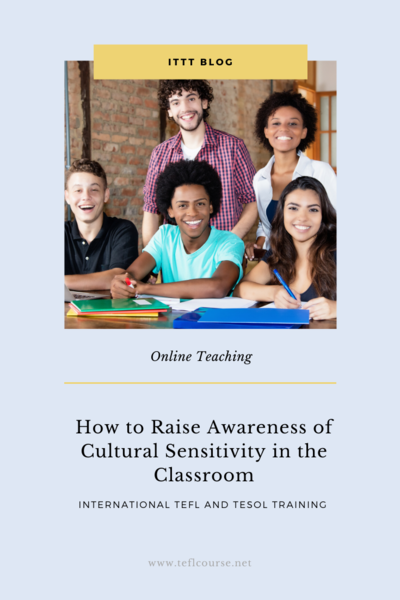How to Raise Awareness of Cultural Sensitivity in the Classroom

A definition of cultural sensitivity is being aware that cultural differences and similarities between people exist without assigning them a value – positive or negative, better or worse, right or wrong. This definition gets the idea across the best.
Table of Contents
The Essence of Cultural Sensitivity
Do you want to teach English abroad? Take a TEFL course!
This post was written by our TEFL certification graduate Aiham W. Please note that this blog post might not necessarily represent the beliefs or opinions of ITTT.
The Essence of Cultural Sensitivity
Within a classroom many people come from many backgrounds, resulting in a variety of cultures being present in one area. To be able to maintain a peaceful working environment, cultural sensitivity must be taken into consideration because, without it, the students present would feel as if their cultural differences would alienate them from one another. Therefore, cultural sensitivity can be described as the awareness of cultural differences and not assigning them any value, creating a form of equality between all cultures present.
If cultural sensitivity was being discussed regarding students at school, then it must be referring to the set of skills that allow students to accept and educate themselves about the cultures surrounding them without belittling the other culture. The main issue at hand is the fact that not many students are exposed to different cultures and react negatively; creating a xenophobic atmosphere that has been learned by a close-minded upbringing by the parents.

Also Read: Shuld I take a TEFL course online or in a classroom?
Solution of the Problem
This form of learned prejudice and racist behavior is the basis of many problems nowadays. We as teachers must be aware of two things. First, not all students are raised in an open-minded household that is accepting other cultures. Second, cultural sensitivity might be a hard task to achieve. However, when we realize and understand the problem in the class, we can find a way to the solution of the problem.
Our mission as teachers is to make the students integrate to a level where everyone loves, understands, respects, and has empathy for each other. When we succeed in doing this, we would be amazed by the results. To achieve our goal, we have to follow a few steps. However, we must keep in mind that these steps are not written in stone and that we can always be more creative about them. A list of examples will be listed below.
Also Read: 7 Effective Speaking Activities for a Mixed-Abilities Classroom
Rapport Building
First, and most importantly, the teacher should get to know the students and build a good relation individually with every student. The teacher must know the students' strengths and values to reach the best outcome of an enriched classroom and help to create engaging lessons that can bridge cultural barriers.

Course Structure
The second is to make sure that the curriculum has a variety of cultural influences. This suggests that we cannot just focus on studying one culture and try to keep an interesting classroom environment by mixing things up. Maybe make a cultural parade in the classroom or even the whole school and let students discover new things about each other's culture.
Also Read: "Slang and Idioms for Business English Learners"
Conquering Prejudice
Third, we as teachers should be aware of our own cultural biases. If we expect our students to be culturally sensitive, we should do the same and be open with ourselves and discover how we can set a perfect example for our students. Fourth, teachers must look for input and support from community members to help us achieve a better knowledge about a diverse classroom. This includes asking other teachers or other community members who have lived in different countries about their experiences.
Do you want to teach English abroad? Take a TEFL course!
In general, we as teachers must be sure that our students will give us authentic work and encourage them to be who they are without being afraid of getting judged or laughed at besides respecting other cultures. I think they would be creative and bring out the best results.
Apply now & get certified to teach english abroad!
Speak with an ITTT advisor today to put together your personal plan for teaching English abroad.
Send us an email or call us toll-free at 1-800-490-0531 to speak with an ITTT advisor today.
Related Articles:
- Online or In-Class - Which TEFL Course Should You Take?
- The Truth About TEFL for Non-Native English Speaking Teachers
- How to Save Money While Teaching English Abroad?
- Two Traveling Teachers Share What It's Like Teaching English Abroad as a Couple
- The 12 Most Affordable Countries For Teaching English Abroad
- The Best Countries to Teach ESL When You're 50+




